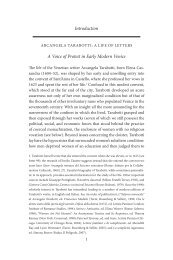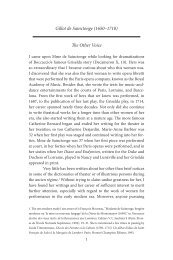Excerpt - Iter: Gateway to the Middle Ages and Renaissance
Excerpt - Iter: Gateway to the Middle Ages and Renaissance
Excerpt - Iter: Gateway to the Middle Ages and Renaissance
Create successful ePaper yourself
Turn your PDF publications into a flip-book with our unique Google optimized e-Paper software.
18 Edi<strong>to</strong>r’s Introduction<br />
is “marketed” or “packaged” as biographical <strong>and</strong> au<strong>to</strong>biographical,<br />
as representing an exemplary life <strong>and</strong> voice from start <strong>to</strong> finish, with<br />
implications in <strong>the</strong> paratext that we will find in this book a unified<br />
<strong>and</strong> edifying poetic voice <strong>and</strong> subject, although such a reading glosses<br />
over <strong>the</strong> complexity of <strong>the</strong> poetic subject <strong>and</strong> its voices in <strong>the</strong> Rymes.<br />
The Trail of Immortal Concern:<br />
Birth, Love, <strong>and</strong> Learning in <strong>the</strong> Rymes 44<br />
Steeped in <strong>the</strong> influences of <strong>the</strong> earlier Rhé<strong>to</strong>riqueurs 45 <strong>and</strong> <strong>the</strong><br />
increasingly popular Petrarchan <strong>and</strong> Italian Neopla<strong>to</strong>nist poetry <strong>and</strong><br />
<strong>the</strong>ories of love, Pernette du Guillet was likely <strong>to</strong> have been welcomed<br />
in <strong>the</strong> thriving literary society of Lyon. The young writer never<strong>the</strong>less<br />
had no models of a female lyric subject <strong>to</strong> follow in <strong>the</strong> process of<br />
creating her own poetic voice. The conventions of Neopla<strong>to</strong>nism<br />
<strong>and</strong> Petrarchism—praising <strong>and</strong> objectifying <strong>the</strong> beloved <strong>and</strong> desired<br />
lady—relegated women <strong>to</strong> silence. In Neopla<strong>to</strong>nic philosophy, despite<br />
an ideal reciprocity of love, <strong>the</strong> woman <strong>and</strong> her physical beauty served<br />
as a rung in <strong>the</strong> ladder of man’s ascent <strong>to</strong> <strong>the</strong> realm of <strong>the</strong> Idea <strong>and</strong><br />
<strong>the</strong> ultimate Good. Similarly, in <strong>the</strong> Petrarchan tradition <strong>the</strong> woman<br />
remained <strong>the</strong> silent object of <strong>the</strong> male gaze. The lover’s suffering from<br />
<strong>the</strong> lady’s lack of response was a precondition for <strong>the</strong> act of writing<br />
poetry. Even in <strong>the</strong> first epigrams of <strong>the</strong> Rymes, however (those that<br />
most closely match <strong>the</strong> interpretation offered by Du Moulin), <strong>the</strong><br />
lyric speaker resists this silent role that literary convention would<br />
thrust upon her. She attributes <strong>the</strong> birth of her self-knowledge, <strong>and</strong><br />
thus of her self-identity, <strong>to</strong> <strong>the</strong> beloved, <strong>and</strong> she honors his eloquence<br />
<strong>and</strong> learning. The voice that expresses that praise, however, does so<br />
in terms that also call attention <strong>to</strong> <strong>the</strong> speaking subject’s own work<br />
as poet.<br />
Critics <strong>and</strong> literary his<strong>to</strong>rians have often pointed <strong>to</strong> <strong>the</strong> first<br />
epigram of <strong>the</strong> Rymes as an example of Du Guillet’s Neopla<strong>to</strong>nism,<br />
typical of her submissive <strong>and</strong> humble stance vis-à-vis <strong>the</strong> male<br />
44. See poem 56, lines 51–54.<br />
45. Rhé<strong>to</strong>riqueurs (or Gr<strong>and</strong> Rhé<strong>to</strong>riqueurs) is <strong>the</strong> term used <strong>to</strong> refer <strong>to</strong> many of <strong>the</strong> French<br />
poets writing at <strong>the</strong> end of <strong>the</strong> fifteenth century <strong>and</strong> in <strong>the</strong> first third of <strong>the</strong> sixteenth century.<br />
Rhyme in verse was considered a type of rhe<strong>to</strong>ric, hence <strong>the</strong> name given <strong>to</strong> <strong>the</strong>se poets, who<br />
were known for <strong>the</strong>ir experimentation with complex rhyme schemes <strong>and</strong> verbal games.<br />
Among <strong>the</strong> best-known Rhé<strong>to</strong>riqueurs are Jean Molinet, Jean Marot, <strong>and</strong> Jean Lemaire de<br />
Belges.




